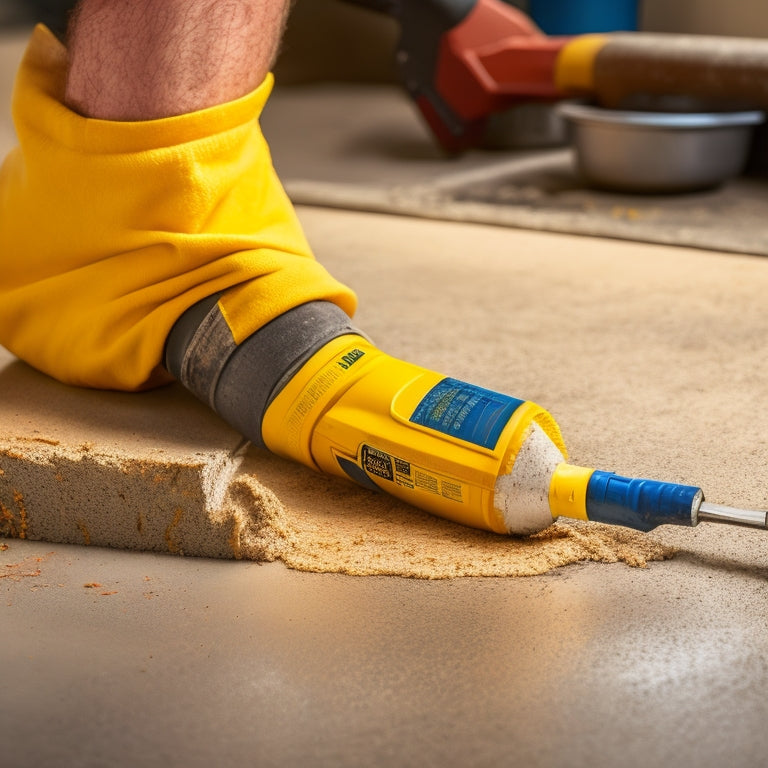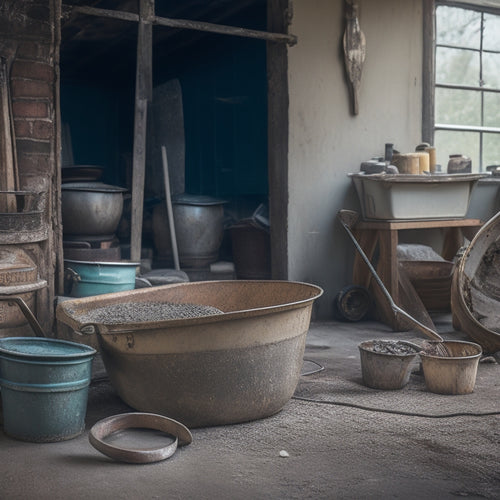
Top 5 Tools for Filling Concrete Cracks Like Pro
Share
When filling concrete cracks like a pro, you need the right tools to guarantee proper repairs and avoid costly rework. Consider essential features like ease of use, versatility, and durability when selecting a tool. For small cracks, opt for a precise control gun with adjustable flow rate and ergonomic design. For best value, choose a cost-effective caulk gun with durable construction and consistent flow. For deep cracks, use a high-pressure injection tool with accurate identification and customizable flow control. And for professional-grade results, invest in a filler gun with precision and efficiency. Explore these top 5 tools to master the art of concrete crack filling.
Key Takeaways
• Consider ease of use, versatility, durability, crack assessment, and environmental conditions when selecting a tool for filling concrete cracks.
• For small cracks, opt for a tool with precise control, accurate application, and efficient filling capabilities.
• For a cost-effective option, choose a durable caulk gun with consistent flow, adjustable pressure control, and versatile use.
• For deep crack repair, use a tool that accurately identifies crack depth, effortlessly selects the right sealant, and has high-pressure injection and adjustable flow control.
• A professional-grade filler gun can target hard-to-reach areas, ensure smooth application, and restore concrete's strength and integrity.
Essential Features to Consider
When selecting a tool for filling concrete cracks, you should prioritize those that offer a combination of ease of use, versatility, and durability. These vital features will directly impact the effectiveness and longevity of the repair. A tool that's easy to use will save you time and effort, while versatility guarantees it can handle various types of cracks and filler materials. Durability, on the other hand, assures the tool will withstand the demands of the job and last for a long time.
Before making a purchase, it's important to conduct a thorough crack assessment to determine the severity and type of cracks you're dealing with. This will help you choose the right filler materials and tool that suits your specific needs. Consider the type of concrete, crack width, and depth, as well as the environmental conditions the repair will be exposed to.
Top Pick for Small Cracks
For small cracks, you'll want a tool that provides pinpoint accuracy and control, allowing you to precisely fill narrow gaps without wasting filler material. When it comes to tackling small cracks, you need a tool that's up to the task. Our top pick for small cracks is a high-quality, precision-designed injection gun. This tool is perfect for filling hairline cracks and small voids, and its accuracy guarantees you'll use just the right amount of filler material.
Here's what makes this tool stand out:
-
Precise control: The injection gun's ergonomic design and adjustable flow rate give you complete control over the filling process.
-
Accurate application: The tool's precision nozzle allows you to target small cracks with ease, reducing waste and mess.
-
Efficient: The gun's high-pressure capabilities enable you to fill cracks quickly and efficiently, saving you time and effort.
- Versatile: This tool is suitable for a range of filler materials, including epoxy, polyurethane, and acrylic.
Best Value for Money Option
You'll get the most bang for your buck with a cost-effective caulk gun that's specifically designed for filling concrete cracks. This budget-friendly option is perfect for DIYers and professionals alike who want to get the job done without breaking the bank.
Look for a gun that's built with durability in mind, featuring a sturdy construction and a comfortable grip that reduces fatigue. When it comes to cost-effective solutions, this caulk gun is hard to beat. It's designed to dispense a consistent flow of sealant, minimizing waste and ensuring a professional-looking finish.
Plus, its adjustable pressure control allows you to customize the flow to suit the size and depth of the crack. With this budget-friendly option, you'll be able to tackle small to medium-sized cracks with ease, without sacrificing quality or performance.
Whether you're a homeowner looking to patch up a few cracks in your driveway or a contractor working on a large-scale project, this caulk gun is an excellent choice. It's a powerful tool that won't blow your budget, making it an essential addition to your toolkit.
Tool for Deep Crack Repair
Tackle deep, stubborn cracks with a heavy-duty injection gun, specifically designed to reach the depths of these imperfections and fill them with a high-strength, flexible sealant.
You'll need a tool that can handle the toughest cracks, and this injection gun delivers. Its robust design and advanced features make it perfect for deep crack repair.
Here's what you can expect from this tool:
-
Accurate deep crack identification: Identify cracks that need attention and assess their depth and severity with ease.
-
Effortless repair material selection: Choose the right sealant for the job, and the gun will handle the rest, ensuring a precise and efficient application.
-
High-pressure injection: Force the sealant deep into the crack, ensuring a strong and lasting bond.
- Adjustable flow control: Customize the flow rate to suit the specific needs of each crack, ensuring a precise and controlled application.
With this heavy-duty injection gun, you'll be able to tackle even the most challenging deep crack repairs with confidence and precision.
Professional-Grade Filler Gun
When deep crack repair is complete, it's time to switch to a professional-grade filler gun for sealing smaller, yet still significant, cracks and crevices that can compromise the structural integrity of the concrete. This tool is designed for precision and efficiency, allowing you to target hard-to-reach areas with ease.
As you prepare to use your filler gun, make certain to follow proper maintenance procedures to guarantee peak performance. Regularly clean the nozzle and tube to prevent clogs, and store the gun in a dry place to prevent rust.
When it comes to application techniques, it's crucial to hold the gun at a 45-degree angle and maintain a consistent flow of filler material. This will help you achieve a smooth, even finish.
For smaller cracks, use a thinner filler material and apply it in thin layers, allowing each layer to dry before applying the next. By following these tips and using a high-quality filler gun, you'll be able to seal even the smallest cracks with precision and confidence.
With the right tool and technique, you'll be able to restore your concrete surface to its original strength and integrity.
Frequently Asked Questions
Can I Use a Hair Dryer to Speed up the Concrete Drying Process?
When you're trying to speed up the concrete drying process, you might consider using a hair dryer, but be cautious.
The hair dryer effects can be deceiving - while it may seem to dry the surface quickly, it can actually create uneven drying and compromise the strength of the concrete.
Instead, focus on proper concrete drying techniques, such as maintaining a consistent temperature and humidity level, to guarantee a strong and durable finish.
How Do I Prevent Concrete Filler From Staining My Skin?
You're probably thinking, 'I'm not a clumsy DIYer, I can handle concrete filler without gloves.' But trust us, it's not worth the risk.
To prevent concrete filler from staining your skin, prioritize concrete safety and skin protection.
Wear heavy-duty gloves, like nitrile or rubber, to create a barrier between your skin and the filler.
Also, apply a skin protectant, such as petroleum jelly or barrier cream, to further shield your skin from unwanted stains.
Are Concrete Crack Fillers Safe to Use Around Pets and Children?
When working with concrete crack fillers, you need to prioritize pet safety and child safety.
Make certain to choose fillers with non-toxic and non-flammable ingredients to avoid any potential harm.
Always follow the manufacturer's instructions and take necessary precautions like wearing gloves and working in well-ventilated areas.
You'll also want to keep pets and kids away from the area until the filler is fully dry and cured to guarantee their safety.
Can I Paint Over a Filled Concrete Crack Immediately?
You're about to put the final strokes on your concrete masterpiece, but hold your brush - can you paint over a filled concrete crack immediately?
Think of it like applying a fresh coat to a wet canvas; it just won't stick. Allow the filler to fully cure, following the manufacturer's recommended drying times.
Then, use proper painting techniques to guarantee a seamless finish. Rushing this step can lead to a peeling, uneven mess, so exercise patience and let the filler set the stage for your artistic touch.
Will Concrete Filler Guns Work With Epoxy-Based Fillers?
When working with epoxy-based fillers, you'll need to guarantee your concrete filler guns are compatible.
Typically, these guns are designed for polyurethane or acrylic-based fillers, but some models can handle epoxy.
To make it work, you'll need to modify your epoxy application techniques, such as using a slower flow rate and thicker mix.
Regular filler gun maintenance is also essential to prevent clogs and guarantee a smooth application.
Conclusion
As you finish reading this article, you're probably thinking, 'I had no idea filling concrete cracks could be so easy!'
And you're right, with the right tools, it's a breeze.
Coincidentally, you now have the top 5 tools to get the job done like a pro.
From small cracks to deep repairs, you're equipped to tackle any concrete crack that comes your way.
So, go ahead, grab your chosen tool, and get ready to fill those cracks with confidence!
Related Posts
-

Top Tools for Mixing Concrete at Home
When mixing concrete at home, you'll need a range of tools to guarantee a successful operation. Start with essential ...
-

Concrete Foundation Building Tools for Homeowners' Success
As you start your concrete foundation building project, it is vital to have the right tools to guarantee success. You...
-

Top Mixing Tools for DIY Concrete Block Laying
When it comes to DIY concrete block laying, the right mixing tools are vital for a strong and durable structure. You'...


